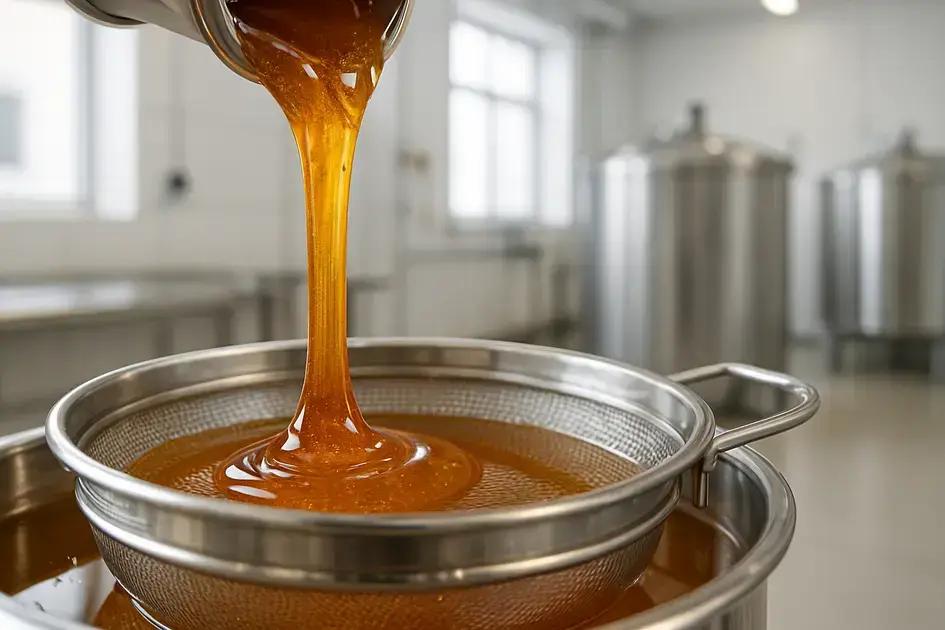=
Bracatinga honey is collected by strategically placing hives near bracatinga forests during flowering, using gentle techniques like smoke to calm bees, followed by careful extraction, filtering, and storage to preserve its natural quality and ensure sustainability.
Ever wondered how bracatinga honey finds its way from bustling beehives to your table? This honey’s journey is unique and fascinating, involving careful collection and processing that brings out its special qualities. Join me as we explore the steps behind this natural treasure.
Understanding bracatinga plants and their importance
The bracatinga plant is a native tree mostly found in Brazil and plays a crucial role in honey production. This tree blooms from winter to early spring, providing an essential source of nectar for bees during times when other flowers are scarce. Its flowers attract a variety of bees, which collect nectar to make honey known for its unique flavor and health benefits.
Characteristics of bracatinga plants
Bracatinga trees are fast-growing and can reach impressive heights. Their white flowers blossom densely, which is perfect for bee colonies as they offer abundant nectar in a relatively short period. This makes the bracatinga an ideal plant for sustainable honey production.
Ecological importance
Besides supporting beekeeping, bracatinga trees help protect soil through their extensive root systems. They contribute to the ecosystem by improving soil quality and providing habitat for various wildlife species. Planting and preserving bracatinga trees supports biodiversity and strengthens the environment.
Understanding the significance of the bracatinga plant helps beekeepers and environmentalists work together to maintain healthy ecosystems and ensure a steady source of natural honey. Its unique flowering pattern and ecological benefits create the foundation for producing quality bracatinga honey.
The beekeeping process for bracatinga honey
Beekeeping for bracatinga honey involves careful timing and attention to the natural cycle of the bracatinga trees. Beekeepers usually place their hives near bracatinga forests before the flowering season begins. This helps ensure that bees have easy access to fresh nectar, improving the quantity and quality of the honey produced.
Setting up the hives
Hives are arranged in locations protected from strong winds and direct sunlight, which helps the bees maintain a stable environment. The beekeeper monitors hive health, ensuring that bees are strong and free from disease. Proper hive management is crucial during the bracatinga flowering season to maximize honey production.
Monitoring bee activity
During the bracatinga bloom, beekeepers track the activity levels of the colonies. Increased flights of bees collecting nectar are a sign that hives will soon be ready for honey extraction. Careful observation helps prevent disturbing the bees while managing hive productivity.
Harvest timing and techniques
Harvesting bracatinga honey happens when the honeycomb cells are capped with wax, indicating the honey is ripe. Beekeepers use gentle methods such as smoke to calm the bees before opening hives. This reduces stress for the bees and keeps the honey pure and uncontaminated.
Through skillful management, beekeepers ensure that bracatinga honey reflects the unique characteristics of this plant, resulting in a high-quality product valued by consumers and nature alike.
Techniques for collecting bracatinga honey
Collecting bracatinga honey requires careful methods to preserve the quality of the honey and protect the bees. Beekeepers use specialized tools and techniques to gently extract honeycombs without harming the hive.
Using smoke to calm bees
One common technique is to use a smoker device that releases cool smoke near the hive entrance. This smoke calms the bees and reduces aggressive behavior, making it safer for the beekeeper to open the hive and work inside.
Removing honeycombs carefully
After the bees are subdued, beekeepers gently remove the honey-filled frames from the hive. They handle the frames with care to avoid breaking the comb or harming the bees. This helps maintain the hive’s strength and ensures future honey production.
Tools for honey extraction
Once the honeycombs are collected, they are taken to a clean area for extraction. Tools like uncapping knives or hot air devices remove the wax caps from the honey cells. Then, a centrifugal extractor spins the frames to separate honey from the comb without crushing it.
Proper hygiene and timing are essential during collection to prevent contamination and preserve the honey’s flavor and medicinal properties. These techniques ensure that bracatinga honey remains pure, fresh, and of high quality for consumers.
Initial processing steps after honey collection

After collecting the honey from the hive, initial processing begins to prepare the honey for storage and sale. One of the first steps is to remove impurities like wax particles, bee parts, and debris that may be mixed in during collection.
Straining the honey
The honey is poured through fine mesh strainers or filters to separate out solids while allowing the smooth liquid honey to pass through. This step is crucial for ensuring the honey’s clarity and quality.
Settling and crystallization
Once strained, the honey is transferred to settling tanks where air bubbles and remaining fine particles can rise to the surface. This process can take a few days and helps improve the texture and taste of the honey.
Temperature control
During processing, maintaining a careful temperature is important to avoid damaging the honey’s natural enzymes and flavor. Most beekeepers use gentle warming methods, keeping honey below 40°C (104°F) to preserve its beneficial properties.
This initial processing ensures that the finished bracatinga honey is clean, pure, and retains the natural qualities that make it sought after by customers worldwide.
Quality control and storage practices
Quality control is essential to ensure that bracatinga honey meets safety standards and maintains its natural flavor and health benefits. Beekeepers and processors regularly test honey for moisture content, purity, and absence of contaminants like pesticides or bacteria.
Testing moisture levels
Honey with too much moisture can ferment or spoil quickly. Using refractometers, producers measure moisture to keep it below 20%, which is the ideal level for long shelf life and proper texture.
Checking for purity
Purity tests confirm that the honey is 100% natural and free from additives or counterfeit products. These checks help protect consumers and maintain trust in bracatinga honey as a premium product.
Proper storage conditions
Honey should be stored in airtight containers away from direct sunlight and heat sources. Cool, dry environments help preserve taste and prevent crystallization. Glass jars or food-grade plastic containers are typically used to store and transport honey.
Maintaining strict quality control and storage practices ensures that bracatinga honey reaches consumers fresh, safe, and delicious.
Environmental and sustainability considerations
Sustainability is a key factor in the production of bracatinga honey. Beekeepers focus on methods that protect the environment and ensure the longevity of both bee populations and bracatinga forests.
Protecting bee habitats
Maintaining natural areas where bracatinga plants grow helps preserve the habitat for local bee species. Healthy bee colonies depend on a diverse and pesticide-free environment for nectar and pollen.
Responsible hive management
Beekeepers practice responsible hive management by avoiding over-harvesting honey, allowing bees enough stores to survive the off-season. This approach supports bee health and reduces colony stress.
Reducing environmental impact
Using organic and non-invasive methods in beekeeping reduces harm to the soil and surrounding wildlife. Minimizing chemical use and managing waste properly helps protect water quality and biodiversity around bracatinga forests.
These environmental and sustainability efforts contribute to producing high-quality bracatinga honey while preserving nature for future generations.
Understanding the journey of bracatinga honey
The process of collecting and processing bracatinga honey involves many detailed steps, from understanding the unique bracatinga plants to practicing sustainable beekeeping. Each stage ensures the honey retains its natural quality and flavor.
Careful techniques in harvesting, processing, and storage keep the honey pure and valuable. At the same time, environmental care protects the bees and the forests they depend on.
This balance between nature and skill creates a special honey that is both delicious and responsibly produced. Exploring this process helps us appreciate the work behind every jar of bracatinga honey.


